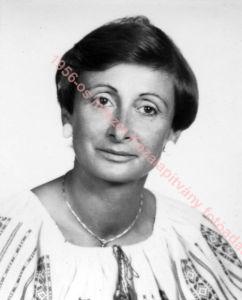 |
Gyenes, Judith (1932) |
 |
 |
 |
 |
|
She was born in Budapest, daughter of lawyer István Gyenes (1897-1972), who resigned from high public service in 1947 in protest against communist influence. He joined the Baranya County National Council of Workers on November 1, 1956, and was sentenced to six years' imprisonment in the Kertész trial, but freed in 1960. Her husband, the army officer Pál Maléter, was appointed defence minister during the 1956 Revolution, and on November 3, headed a military delegation negotiating at the Soviet headquarters at Tököl where he was arrested by General Ivan A. Serov, head of the KGB. Maléter was tried and sentenced to death in the Imre Nagy trial and executed on June 16, 1958. Judith Gyenes was barred from higher education for her family background and went to work in the National Plant Experimental Institute. She (and Maléter) was admitted to the Agricultural University in 1955, but expelled on the same grounds in 1957, when she also lost her job. She then worked as a landscaper and cemetery worker under her maiden name. She was evicted from her flat in June 1957. Living by casual work from autumn 1958, it was years before she obtained a regular job at the Pest-Nógrád County State Farms' Centre. She joined the staff of the National Rheumatology and Physiotherapy Institute in 1982, while completing a course in librarianship. In the spring of 1985, she transferred to the National Medical Library, and in 1992, became librarian of the 1956 Institute. She regularly took part in opposition meetings from June 1983 onwards. As a founder of the Historical Justice Committee, she was among the campaigners for the rehabilitation and a worthy burial of the martyrs of 1956. She received a 1956 Memorial Certificate in 1990 and a Pál Maléter Memorial Medal in 1999. |
|
 |
 |
 |
|
|
|
|
